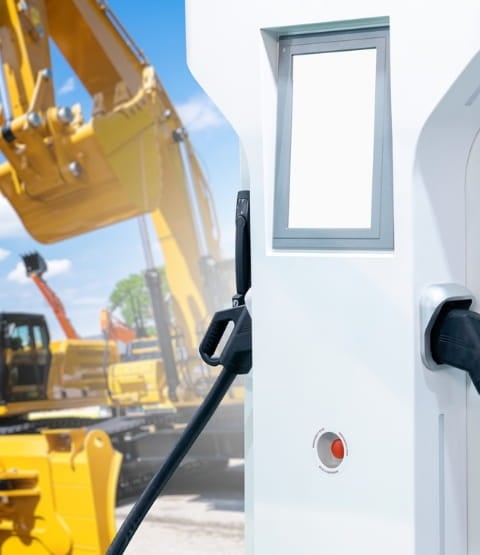The construction sector is moving towards more sustainable solutions, with electrification emerging as a major challenge for reducing CO2 emissions and improving energy efficiency on worksites. This issue was at the centre of discussions at INTERMAT 2024, which hosted almost 1,000 exhibitors. Industry leaders such as Volvo and Kiloutou, present on the TV set within the industry space, were able to share their innovative solutions during the debate : « Electrification: the other challenge of the energy transition ». Designed for construction site equipment and power supplies, these practices are increasingly being adopted by certain players in the industry. Whether they are manufacturers, rental companies, or operators, we asked them to share their experiences with us.

Electrification : autonomy at stake
Charging solutions: a challenge to be met
Charging infrastructures, particularly at temporary worksites, present a challenge. According to Davy Guillemard, « setting up charging stations adapted to the specific needs of construction equipment remains a logistical challenge. » A report by the Fédération Nationale des Travaux Publics (FNTP) states that worksites will need to develop fast-charging solutions to facilitate the wider adoption of electric machines. By 2030, it is estimated that the construction sector will require five times as many charging stations. Given this need, new charging infrastructure technologies are more innovative than ever. This is why the importance of collaborating with stakeholders in this sector to develop flexible solutions, such as portable batteries (power banks), is regularly highlighted. These solutions are also being studied to improve machine recharging on construction projects (see media player). To test these changes in real-life conditions designed to make construction more eco-friendly, equipment rental companies have taken up the challenge.
Rental companies mobilized to transform usage
To ensure that electrification becomes a solution deployed on a wider scale, equipment rental companies are taking the transformation of usage into their own hands.
Olivier Colleau, Executive Chairman of the Kiloutou Group, emphasised their crucial role in integrating and adapting solutions that promote the energy transition. Indeed, « renting equipment reduces the carbon footprint and enables more efficient pooling of resources ». Moreower, « a third of Kiloutou's investments are devoted to low-carbon equipment, mainly electric ». According to the European Construction Equipment Manufacturers' Organisation (CECE), demand for such low-carbon equipment is rising steadily, with projected growth of 38% by 2030. The sector is becoming increasingly aware of the solutions needed to improve the carbon footprint of construction sites by involving the various stakeholders. Progress is being made. Flavien Leroy, Managing Director of BOMAG France, states that « field trials with electric machines have proven effective in terms of autonomy and noise reduction ». This observation aligns with the findings of a study by the French Agency for Ecological Transition (ADEME), which indicates that electric machines reduce noise pollution by 50%—a crucial advantage for worksites in urban areas. In this way, CSR commitments are aligned with greater sustainability and less impact on the daily lives of local residents. The benefits are evident. However, the initial costs of this transformation are often cited as a significant factor that needs to be addressed to accelerate the transition to electrification.
Electrification, the other challenge of the energy transition
Investments pay off for a sustainable transformation
The construction sector's synergy around electrification issues is now bearing fruit, and the progress is encouraging. Operators are also being trained to use the new equipment. However, there is still room for improvement to accelerate this transition. According to Olivier Colleau, electrical equipment is still « two to three times more expensive than combustion engines ». This issue needs to be addressed to introduce financial incentives that encourage their adoption. Industry players are united in calling for legislation to provide these financial incentives for the adoption of green solutions. Several options are proposed, such as subsidies and/or tax incentives, designed to promote the purchase of electric equipment, akin to the ecological bonuses introduced in the automotive sector.
More INTERMAT
A one-stop shop for industry news
We will continue to address the challenges and solutions of greener construction, including electrification. The next edition will be a unique opportunity to discover all the inspiring solutions shaping the future of sustainable construction. You'll also find live demonstrations and innovations aligned with the requirements of carbon neutrality by 2050.






